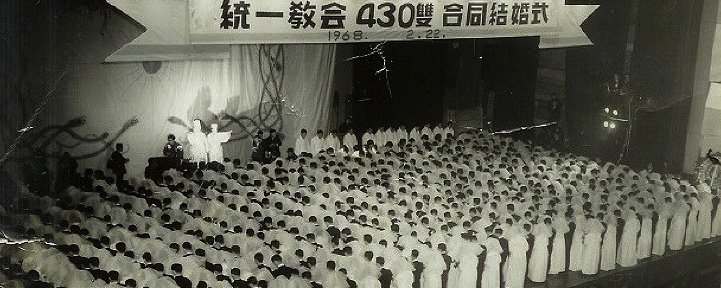This Week in History: February 16-22
“This Week in History” briefly lists significant events in the history of the Unification Church, the lives of the Founders, and world events that are momentous to Unificationists. Most items are marked according to the solar calendar. Items marked “H.C.” correspond to the Cheon-gi or Heavenly Calendar, which is based on the lunar calendar. This installment covers the week of February 16-22.
February 22, 1968

True Parents bless 430 couples in Korea on February 22, 1968.
46th Anniversary of the 430-Couple Blessing
The 430-Couple Blessing was held at the Seoul Civic Center on February 22, 1968. According to True Father, the Blessing of 430 Couples represents the establishment of national indemnity. In the 4,300th year of Korean history, True Father blessed the 430 Couples. It also represents the number of years of the Israelites’ slavery in Egypt. Therefore, the Blessing of 430 Couples means the liberation of the nation of Israel. (Excerpt from Blessing and Ideal Family, Part 2)
February 21, 1976
Blessing of 74 couples
True Father conducted a Blessing Marriage Ceremony of 74 couples on February 21, 1976, “so everyone could be happy” and drew his birthday remarks to a dramatic conclusion by saying:
“From this moment on, the more opposition we get, the more victories. Anything the outside will give to us in the form of persecution, suffering and pressure, an equal amount of blessing will be restored to us. … The winning of territory inch by inch will continue to the year 2000. Every day’s work will accumulate to the Kingdom of God from this time on. Even though the satanic world is attacking, they are no longer advancing. We are the force that is advancing.”
February 18, 1976

Senator Robert Dole (R-Kansas) chaired sessions on February 18, 1976, that allowed Church critics to air grievances before officials from seven government agencies.
Sen. Robert Dole persecuted the Unification Church
On February 18, 1976, anti-Unification Church organizations sponsored “A Day of Affirmation and Protest” in Washington, D.C., which included a two-hour presentation of grievances against the Church to U.S. Senator Robert Dole (R-Kansas) and representatives of seven U.S. government agencies. The “Dole hearing” provided Church critics with a well-publicized, credible forum in which to air their grievances before important national-level figures. More troubling was the fact that Church representatives were excluded from the proceedings. Senator Dole refused to meet with HSA President Neil Salonen, and Church members could only maintain a vigil of protest at the back of the meeting room. Whereas the movement was able to conduct its Day of Hope tours within a climate of receptivity, the Yankee Stadium and Washington Monument rallies of 1976 unfolded within a climate of increasing negativity and even persecution.
